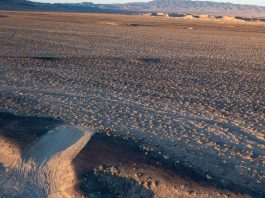Century Lithium recently completed a Feasibility Study on its Clayton Valley Lithium Project and is currently in the permitting stage, with the goal of becoming a domestic producer of lithium for the growing electric vehicle and battery storage market.
The Clayton Valley Lithium Project represents a significant step in securing a low-cost, large-scale, and enduring lithium supply.
Recognised as the third most advanced lithium initiative in Nevada, this Project taps into a substantial lithium-bearing claystone deposit.
With significant progress already achieved in 2024, the Company provides an update on the project’s Feasibility Study and its importance in establishing a domestic lithium supply chain.
Why does the US need a domestic lithium supply chain?
Establishing domestic lithium production in the United States is crucial for several economic, technological, and strategic reasons.
According to the US Geological Survey, the country holds around 3.6% of global lithium reserves. Currently, the US’ only lithium producer is in Nevada and the world’s lithium production power is centred in China.
The US has always relied heavily on lithium imports from foreign sources, most notably from countries like Chile, Argentina, and Australia. However, this causes issues with supply chains, such as disruption and economic risks.
Establishing domestic production mitigates these risks, ensuring a consistent and secure supply of lithium for the nation’s burgeoning clean energy initiatives.
Century Lithium is helping boost domestic lithium production through its Clayton Valley Lithium Project – an extensive resource of lithium-bearing claystone totalling 5,585 acres in west central Nevada.
About the Clayton Valley Lithium Project
The Clayton Valley Lithium Project is a large-scale Nevada-based Lithium Project with a three-phase production plan that will generate a life-of-mine average of 34,000 tonnes per annum (tpa) of battery-quality lithium carbonate (Li2CO3).
Century Lithium owns 100% of the Clayton Valley Lithium Project which totals over 5,585 acres in west central Nevada, USA.
It boasts its location in Esmeralda County, immediately east of Albemarle’s Silver Peak mine – North America’s only lithium brine operation.
Highlights of the project include:
• Shallow surface mine
• Large-scale Nevada-based lithium project
• Innovative approach in processing: using sustainable chloride-based leaching and DLE
• Long 40-year mine life
• Designed for expansion
• 17.1% internal rate of return (IRR) after tax
• Low operating cost ($2,766/t)
• Positive economics: After-tax IRR of 17.1% and $3.01 billion NPV-8%
Exposed at the surface, the lithium resource is sheltered from erosion by Angel Island.
A large depository of lithium claystone benefits the project’s favourable characteristics and location. This claystone is easily minable and amenable to modern processing.
With a long mine life of over 40 years, Century Lithium’s project is currently the third most advanced stage lithium project in Nevada.
Because of this, Century Lithium has a very favourable positioning in leveraging the current strong demand for lithium in the US, through its advancement of domestic lithium production.
Feasibility Study highlights
Presenting the study, Bill Willoughby, President and CEO of Century Lithium, commented: “Century Lithium is proud to present our Feasibility Study. It indicates the Clayton Valley Lithium Project has robust economics, made possible with our unique chlor-alkali and DLE processes.”
“Our process technology was developed by way of many trials and successes at our Pilot Plant in Amargosa Valley. As one of the few lithium-focused plants in North America, we continue to operate safely and recently passed two years of testing.”
He concluded: “The data generated to date supports the Feasibility Study, and we continue to test various conditions and ideas to improve our process flow sheet.”
The results, supported by over two years of testing at the company’s pilot plant, found that the three-phase production plan will generate a life-of-mine average of 34,000 tonnes per annum (tpa) of battery-quality lithium carbonate (Li2CO3).
An average lithium recovery of 78% was used in the study based on the data collected over two years of operations at Century Lithium’s pilot plant.
The results indicated:
• Feed material grades averaged 1,100 ppm
• Leach solution samples varied from 200 to 320 ppm Li
• Lithium extractions averaged 88% and varied from 80 to 95%
• DLE lithium recoveries were typically above 90%
• 10% of the lithium in solution is retained in the moisture remaining in the tailings
Extraction rates do not account for losses downstream and are only indicative of the potential overall recovery.
Work at the Pilot Plant continues to focus on reducing losses of lithium to tailings. A small loss of lithium from processing the DLE product solutions into Li2CO3, and the recycling of process solutions to the DLE and leach areas is anticipated.
Clayton Valley future production plan
The Clayton Valley Project’s production plan comprises three equal phases of production rate increases. Phase 1 and Phase 2 production rates are maintained for five years each, and Phase 3 is maintained for 30 years.
This approach was selected to reduce capital exposure and risk by dividing the Project’s production schedule into realistic phases of construction and equipment installation.
Phase 1 includes all work required to implement the Initial Project Plan, including all necessary mining and processing infrastructure. The Phase 2 cost estimate focuses on an expansion within the footprint of Phase 1.
Phase 3 development includes an additional processing plant and facilities not built in the previous phases and allows for a fourth phase of expansion.
Recommendations for project advancement
Century Lithium has completed multiple environmental studies in advance of permitting and is examining ways to optimise power requirements and incorporate alternative energy solutions.
The Feasibility Study’s recommendations include continuing the permitting process, engaging with governmental agencies and other parties, and proceeding with detailed engineering to further advance the Clayton Valley Project.
Therefore, the company has contacted the U.S. Department of Energy’s (DOE) Loan Programs Office (LPO) and plans to initiate the pre-application process under the Title Seven Clean Energy Financing program when the Feasibility Study report is complete.











